Answered step by step
Verified Expert Solution
Question
1 Approved Answer
500 CHAPTER 9 Graphic Illustrations CHECK YOUR COMPREHENSION After reading the selection, answer the following questions with a, b, c, ord. To help you analyze
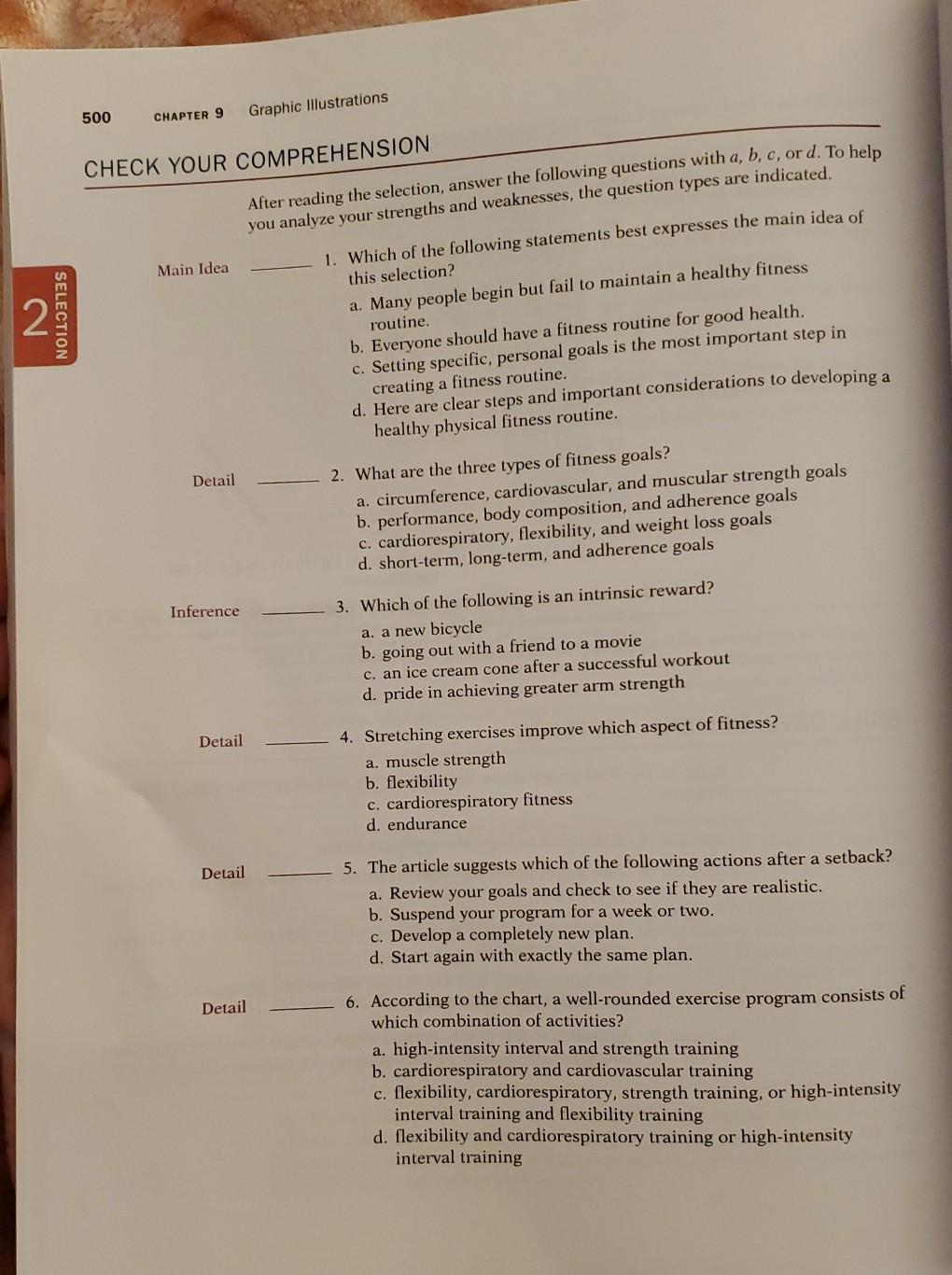
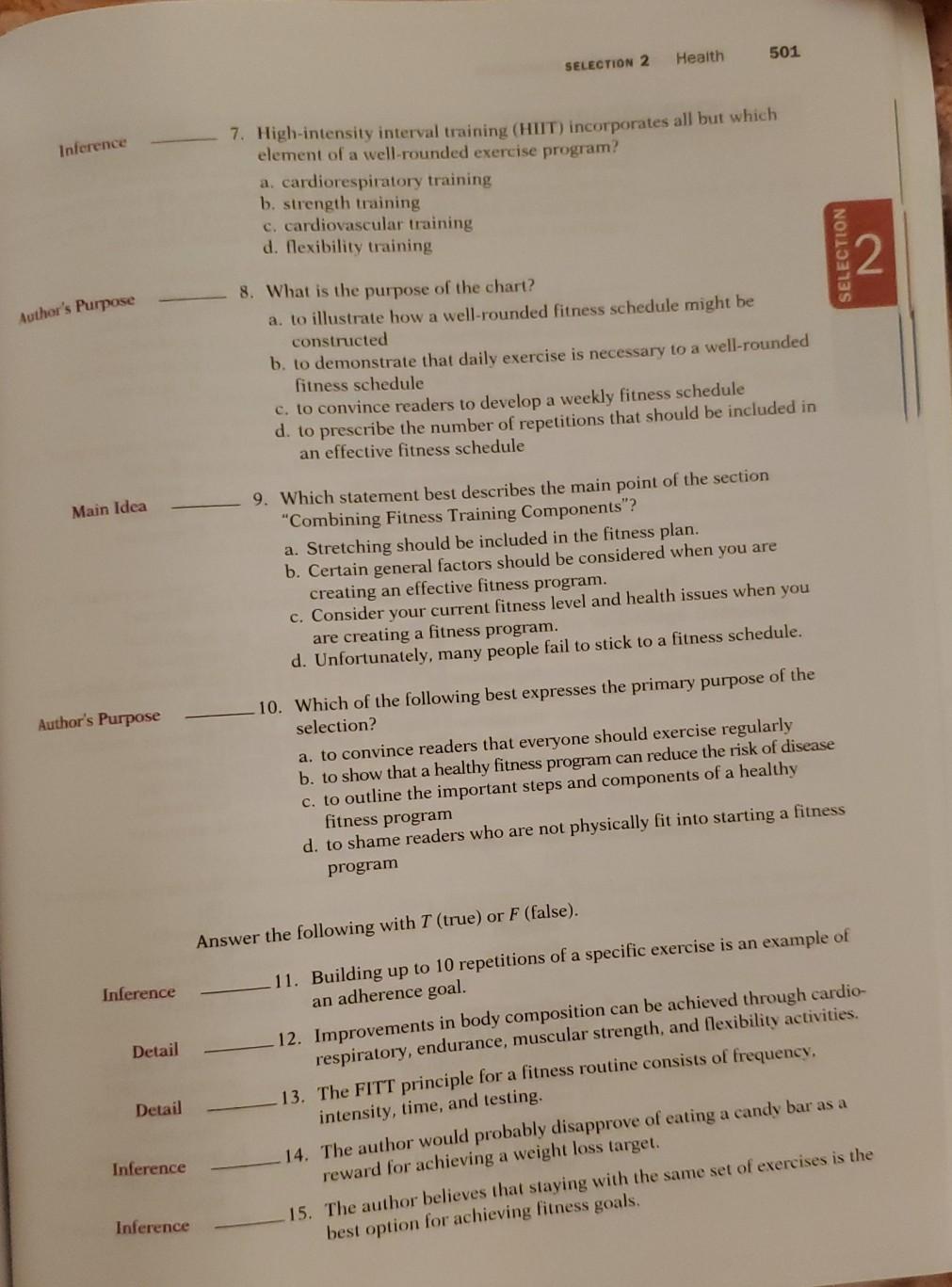
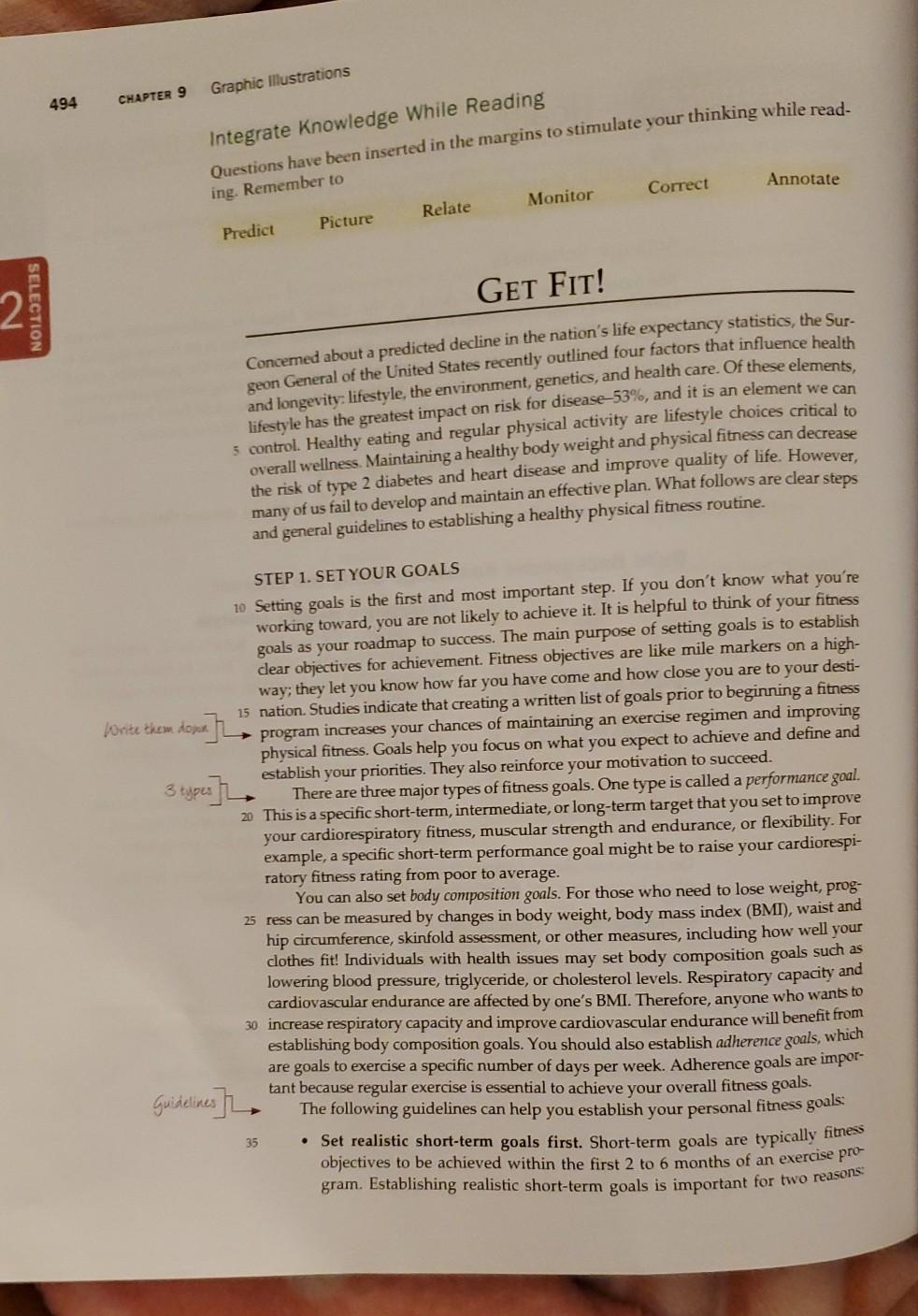
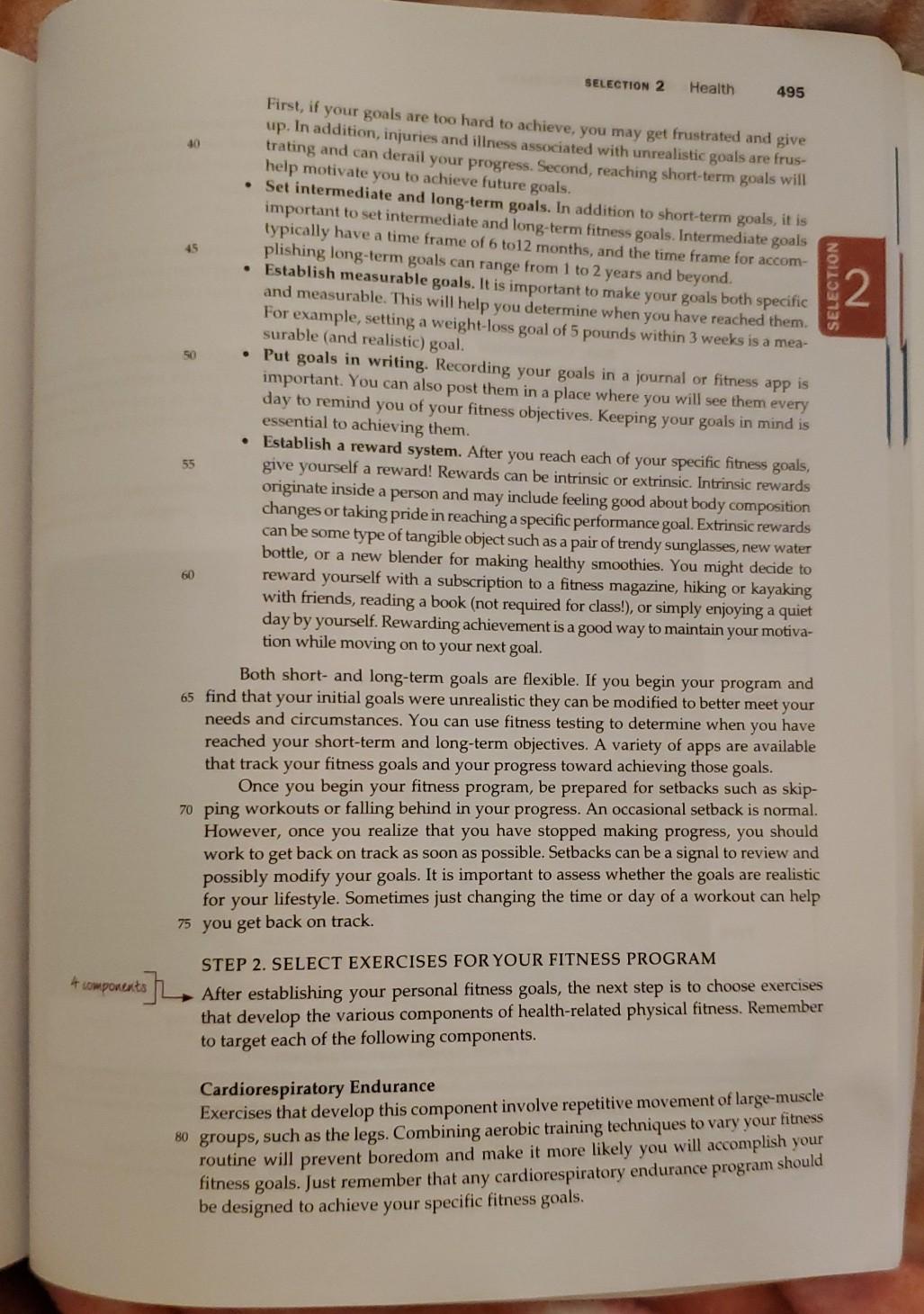
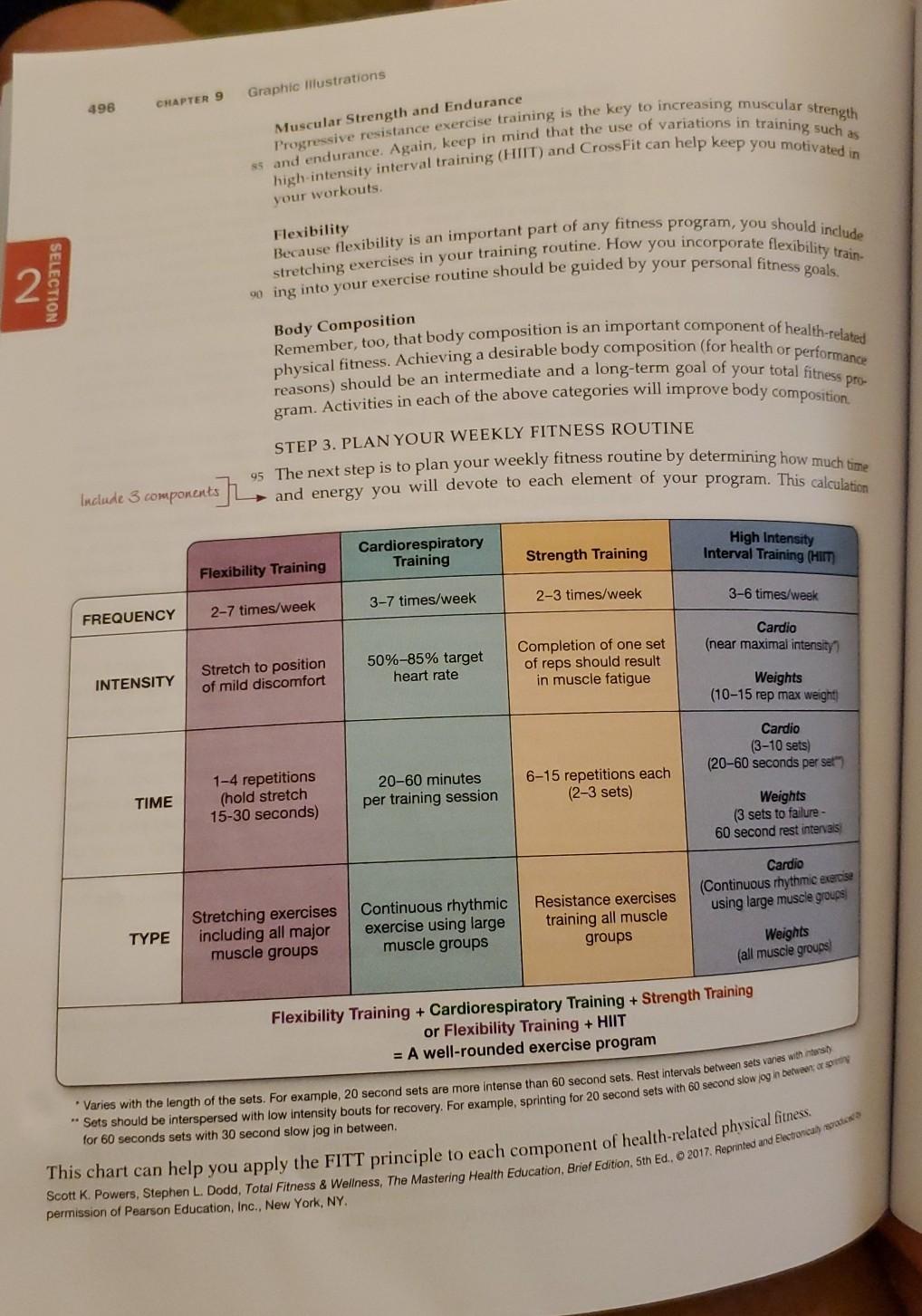
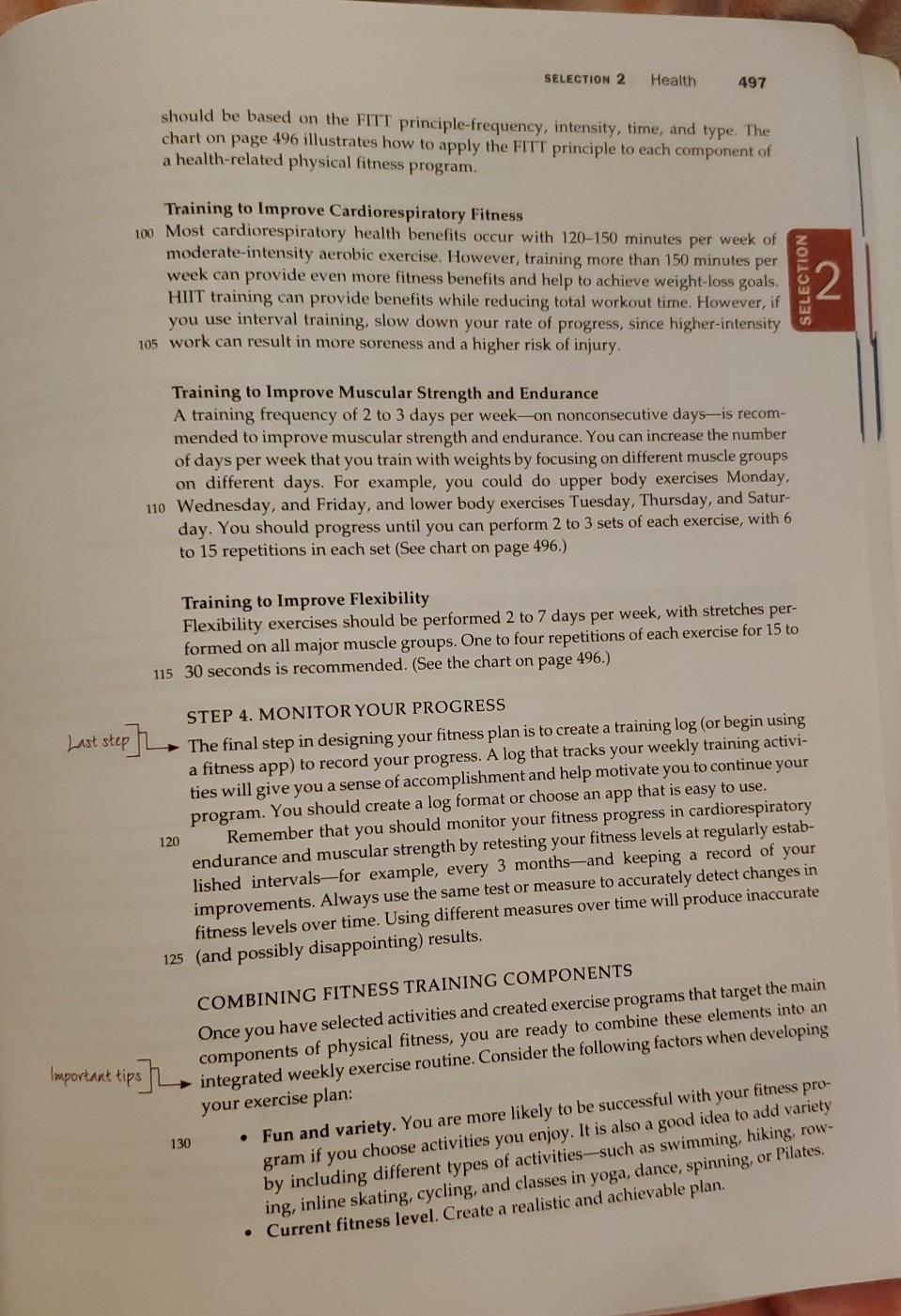

500 CHAPTER 9 Graphic Illustrations CHECK YOUR COMPREHENSION After reading the selection, answer the following questions with a, b, c, ord. To help you analyze your strengths and weaknesses, the question types are indicated. Main Idea 2 SELECTION 1. Which of the following statements best expresses the main idea of this selection? a. Many people begin but fail to maintain a healthy fitness routine. b. Everyone should have a fitness routine for good health. c. Setting specific, personal goals is the most important step in creating a fitness routine. d. Here are clear steps and important considerations to developing a healthy physical fitness routine. Detail 2. What are the three types of fitness goals? a. circumference, cardiovascular, and muscular strength goals b. performance, body composition, and adherence goals c. cardiorespiratory, flexibility, and weight loss goals d. short-term, long-term, and adherence goals Inference 3. Which of the following is an intrinsic reward? a. a new bicycle b. going out with a friend to a movie c. an ice cream cone after a successful workout d. pride in achieving greater arm strength Detail 4. Stretching exercises improve which aspect of fitness? a. muscle strength b. flexibility c. cardiorespiratory fitness d. endurance Detail 5. The article suggests which of the following actions after a setback? a. Review your goals and check to see if they are realistic. b. Suspend your program for a week or two. c. Develop a completely new plan. d. Start again with exactly the same plan. Detail 6. According to the chart, a well-rounded exercise program consists of which combination of activities? a. high-intensity interval and strength training b. cardiorespiratory and cardiovascular training c. flexibility, cardiorespiratory, strength training, or high-intensity interval training and flexibility training d. flexibility and cardiorespiratory training or high-intensity interval training Health 501 SELECTION 2 Inference 7. High-intensity interval training (HIIT) incorporates all but which element of a well-rounded exercise program? a. cardiorespiratory training b. strength training c. cardiovascular training d. flexibility training SELECTION 2 Author's Purpose 8. What is the purpose of the chart? a. to illustrate how a well-rounded fitness schedule might be constructed b. to demonstrate that daily exercise is necessary to a well-rounded fitness schedule c. to convince readers to develop a weekly fitness schedule d. to prescribe the number of repetitions that should be included in an effective fitness schedule Main Idea 9. Which statement best describes the main point of the section "Combining Fitness Training Components"? a. Stretching should be included in the fitness plan. b. Certain general factors should be considered when you are creating an effective fitness program. c. Consider your current fitness level and health issues when you are creating a fitness program. d. Unfortunately, many people fail to stick to a fitness schedule. Author's Purpose 10. Which of the following best expresses the primary purpose of the selection? a. to convince readers that everyone should exercise regularly b. to show that a healthy fitness program can reduce the risk of disease c. to outline the important steps and components of a healthy fitness program d. to shame readers who are not physically fit into starting a fitness program Answer the following with T (true) or F (false). Inference Detail Detail 11. Building up to 10 repetitions of a specific exercise is an example of an adherence goal. 12. Improvements in body composition can be achieved through cardio- respiratory, endurance, muscular strength, and flexibility activities. 13. The FITT principle for a fitness routine consists of frequency, intensity, time, and testing. 14. The author would probably disapprove of eating a candy bar as a reward for achieving a weight loss target. 15. The author believes that staying with the same set of exercises is the best option for achieving fitness goals, Inference Inference Graphic Illustrations 494 CHAPTER 9 Integrate knowledge While Reading Questions have been inserted in the margins to stimulate your thinking while read ing. Remember to Annotate Correct Monitor Relate Picture Predict GET FIT! 2 SELECTION Concemed about a predicted decline in the nation's life expectancy statistics, the Sur- geon General of the United States recently outlined four factors that influence health and longevity: lifestyle, the environment, genetics, and health care. Of these elements, lifestyle has the greatest impact on risk for disease-53%, and it is an element we can 5 control. Healthy eating and regular physical activity are lifestyle choices critical to overall wellness. Maintaining a healthy body weight and physical fitness can decrease the risk of type 2 diabetes and heart disease and improve quality of life. However, many of us fail to develop and maintain an effective plan. What follows are clear steps and general guidelines to establishing a healthy physical fitness routine. 3 types STEP 1. SET YOUR GOALS 10 Setting goals is the first and most important step. If you don't know what you're working toward, you are not likely to achieve it. It is helpful to think of your fitness goals as your roadmap to success. The main purpose of setting goals is to establish clear objectives for achievement. Fitness objectives are like mile markers on a high- way; they let you know how far you have come and how close you are to your desti- 15 nation. Studies indicate that creating a written list of goals prior to beginning a fitness Write them down. program increases your chances of maintaining an exercise regimen and improving physical fitness. Goals help you focus on what you expect to achieve and define and establish your priorities. They also reinforce your motivation to succeed. There are three major types of fitness goals. One type is called a performance goal. 20 This is a specific short-term, intermediate, or long-term target that you set to improve your cardiorespiratory fitness, muscular strength and endurance, or flexibility. For example, a specific short-term performance goal might be to raise your cardiorespi- ratory fitness rating from poor to average. You can also set body composition goals. For those who need to lose weight, prog- 25 ress can be measured by changes in body weight, body mass index (BMI), waist and hip circumference, skinfold assessment, or other measures, including how well your dothes fit! Individuals with health issues may set body composition goals such as lowering blood pressure, triglyceride, or cholesterol levels. Respiratory capacity and cardiovascular endurance are affected by one's BMI. Therefore, anyone who wants to 30 increase respiratory capacity and improve cardiovascular endurance will benefit from establishing body composition goals. You should also establish adherence goals, which are goals to exercise a specific number of days per week. Adherence goals are impor- tant because regular exercise is essential to achieve your overall fitness goals. Guidelines 2 The following guidelines can help you establish your personal fitness goals: Set realistic short-term goals first. Short-term goals are typically fitness objectives to be achieved within the first 2 to 6 months of an exercise pro gram. Establishing realistic short-term goals is important for two reasons 35 SELECTION 2 Health 495 40 45 SELECTION 2 First, if your goals are too hard to achieve, you may get frustrated and give up. In addition, injuries and illness associated with unrealistic goals are frus- trating and can derail your progress. Second, reaching short-term goals will help motivate you to achieve future goals. Set intermediate and long-term goals. In addition to short-term goals, it is important to set intermediate and long-term fitness goals. Intermediate goals typically have a time frame of 6 to 12 months, and the time frame for accom- plishing long-term goals can range from 1 to 2 years and beyond. Establish measurable goals. It is important to make your goals both specific and measurable. This will help you determine when you have reached them. For example, setting a weight-loss goal of 5 pounds within 3 weeks is a mea- surable (and realistic) goal. Put goals in writing. Recording your goals in a journal or fitness app is important. You can also post them in a place where you will see them every day to remind you of your fitness objectives. Keeping your goals in mind is essential to achieving them. Establish a reward system. After you reach each of your specific fitness goals, 55 give yourself a reward! Rewards can be intrinsic or extrinsic. Intrinsic rewards originate inside a person and may include feeling good about body composition changes or taking pride in reaching a specific performance goal. Extrinsic rewards can be some type of tangible object such as a pair of trendy sunglasses, new water bottle, or a new blender for making healthy smoothies. You might decide to reward yourself with a subscription to a fitness magazine, hiking or kayaking with friends, reading a book (not required for class!), or simply enjoying a quiet day by yourself. Rewarding achievement is a good way to maintain your motiva- tion while moving on to your next goal. Both short- and long-term goals are flexible. If you begin your program and 65 find that your initial goals were unrealistic they can be modified to better meet your needs and circumstances. You can use fitness testing to determine when you have reached your short-term and long-term objectives. A variety of apps are available that track your fitness goals and your progress toward achieving those goals. Once you begin your fitness program, be prepared for setbacks such as skip- 70 ping workouts or falling behind in your progress. An occasional setback is normal. However, once you realize that you have stopped making progress, you should work to get back on track as soon as possible. Setbacks can be a signal to review and possibly modify your goals. It is important to assess whether the goals are realistic for your lifestyle. Sometimes just changing the time or day of a workout can help 60 75 you get back on track. + components STEP 2. SELECT EXERCISES FOR YOUR FITNESS PROGRAM After establishing your personal fitness goals, the next step is to choose exercises that develop the various components of health-related physical fitness. Remember to target each of the following components. Cardiorespiratory Endurance Exercises that develop this component involve repetitive movement of large-muscle 80 groups, such as the legs. Combining aerobic training techniques to vary your fitness routine will prevent boredom and make it more likely you will accomplish your fitness goals. Just remember that any cardiorespiratory endurance program should be designed to achieve your specific fitness goals. Graphic Illustrations 498 CHAPTER 9 Muscular Strength and Endurance your workouts Flexibility 2 SELECTION Body Composition STEP 3. PLAN YOUR WEEKLY FITNESS ROUTINE 95 The next step is to plan your weekly fitness routine by determining how much time Include 3 components High Intensity Interval Training (Him Strength Training Progressive resistance exercise training is the key to increasing muscular strength 55 and endurance. Again, keep in mind that the use of variations in training such as high-intensity interval training (HIIT) and CrossFit can help keep you motivated in Because flexibility is an important part of any fitness program, you should include stretching exercises in your training routine. How you incorporate flexibility train 90 ing into your exercise routine should be guided by your personal fitness goals. Remember, too, that body composition is an important component of health-related physical fitness. Achieving a desirable body composition (for health or performance reasons) should be an intermediate and a long-term goal of your total fitness pro- gram. Activities in each of the above categories will improve body composition and energy you will devote to each element of your program. This calculation * Sets should be interspersed with low intensity bouts for recovery. For example, sprinting for 20 second sets with 60 second slow og in between any This chart can help you apply the FITT principle to each component of health-related physical fitness Scott K. Powers, Stephen L. Dodd, Total Fitness & Wellness, The Mastering Health Education, Brief Edition, 5th Ed., 2017. Reprinted and Electronica) sa Cardiorespiratory Training 2-7 times/week 3-7 times/week 50%-85% target heart rate 1-4 repetitions 20-60 minutes TIME (hold stretch per training session 15-30 seconds) Stretching exercises Continuous rhythmic TYPE including all major exercise using large muscle groups muscle groups for 60 seconds sets with 30 second slow jog in between Flexibility Training 2-3 times/week 3-6 times/week FREQUENCY Cardio (near maximal intensity Completion of one set of reps should result in muscle fatigue Stretch to position of mild discomfort INTENSITY Weights (10-15 rep max weight) Cardio (3-10 sets) (20-60 seconds per set 6-15 repetitions each (2-3 sets) Weights (3 sets to failure - 60 second rest intervals Cardio (Continuous rhythmic exercise using large muscle groups Resistance exercises training all muscle groups Weights (all muscle groups Flexibility Training + Cardiorespiratory Training + Strength Training or Flexibility Training + HIIT = A well-rounded exercise program Varies with the length of the sets. For example, 20 second sets are more intense than 60 second sets. Rest intervals between ses varies women permission of Pearson Education, Inc., New York, NY. SELECTION 2 Health 497 should be based on the FITT principle-frequency, intensity, time, and type. The chart on page 496 illustrates how to apply the FITT principle to each component of a health-related physical fitness program Training to Improve Cardiorespiratory Fitness 100 Most cardiorespiratory health benefits occur with 120-150 minutes per week of moderate-intensity aerobic exercise. However, training more than 150 minutes per week can provide even more fitness benefits and help to achieve weight-loss goals. 2 HIIT training can provide benefits while reducing total workout time. However, if you use interval training, slow down your rate of progress, since higher-intensity 105 work can result in more soreness and a higher risk of injury. Training to Improve Muscular Strength and Endurance A training frequency of 2 to 3 days per week-on nonconsecutive days-is recom- mended to improve muscular strength and endurance. You can increase the number of days per week that you train with weights by focusing on different muscle groups on different days. For example, you could do upper body exercises Monday, 110 Wednesday, and Friday, and lower body exercises Tuesday, Thursday, and Satur- day. You should progress until you can perform 2 to 3 sets of each exercise, with 6 to 15 repetitions in each set (See chart on page 496.) Training to Improve Flexibility Flexibility exercises should be performed 2 to 7 days per week, with stretches per- formed on all major muscle groups. One to four repetitions of each exercise for 15 to 115 30 seconds is recommended. (See the chart on page 496.) Last step STEP 4. MONITOR YOUR PROGRESS The final step in designing your fitness plan is to create a training log (or begin using a fitness app) to record your progress. A log that tracks your weekly training activi- ties will give you a sense of accomplishment and help motivate you to continue your program. You should create a log format or choose an app that is easy to use. Remember that you should monitor your fitness progress in cardiorespiratory endurance and muscular strength by retesting your fitness levels at regularly estab- lished intervals-for example, every 3 months-and keeping a record of your improvements. Always use the same test or measure to accurately detect changes in fitness levels over time. Using different measures over time will produce inaccurate 125 (and possibly disappointing) results. 120 Important tips COMBINING FITNESS TRAINING COMPONENTS Once you have selected activities and created exercise programs that target the main components of physical fitness, you are ready to combine these elements into an integrated weekly exercise routine. Consider the following factors when developing your exercise plan: Fun and variety. You are more likely to be successful with your fitness pro- gram if you choose activities you enjoy. It is also a good idea to add variety by including different types of activities-such as swimming, hiking, row- ing, inline skating, cycling, and classes in yoga, dance, spinning, or Pilates Current fitness level. Create a realistic and achievable plan. 130 Graphic Illustrations CHAPTER 9 Special health issues. Consult your doctor for advice about a plan that con- Muscle strain. Muscles need time to recover after training. Alternate the Flexibility training. Stretch at least two days each week. Many people like to Progress gradually. Small increases in intensity will help you avoid injury Remember, fitness cannot be stored! If you stop being active, you lose fitness days on which you work on specific muscle groups. while still making noticeable progress toward your fitness goal. 135 siders your situation. 140 stretch after every workout. and the health benefits you worked so hard to achieve. (1709 words) -From Scott K. Powers, Stephen L. Dodd, Total Fitness & Wellness , The Mastering Health Education, Brief Edition, 5th Ed., 2017. Reprinted and Electronically reproduced by permission of Pearson Education, Inc., New York, NY
Step by Step Solution
There are 3 Steps involved in it
Step: 1

Get Instant Access to Expert-Tailored Solutions
See step-by-step solutions with expert insights and AI powered tools for academic success
Step: 2

Step: 3

Ace Your Homework with AI
Get the answers you need in no time with our AI-driven, step-by-step assistance
Get Started


